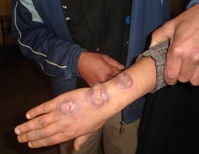 Zoonotic cutaneous leishmaniasis in emerging foci tends to create severe lesionsMorocco comprises several vegetation zones which reflect varied climate and topography and influence the distribution and density of sandfly species and consequently of Leishmania species.
Zoonotic cutaneous leishmaniasis in emerging foci tends to create severe lesionsMorocco comprises several vegetation zones which reflect varied climate and topography and influence the distribution and density of sandfly species and consequently of Leishmania species.
This environmental complexity is reflected in the diversity of leishmaniasis. L. infantum, L. major and L. tropica all occur, each in a specific range of vegetation types (bioclimatic stages).
Zoonotic cutaneous leishmaniasis due to L. major occurs in unpredictable outbreaks in the south and south-east; Phlebotomus papatasi is the vector and the reservoir host has been identified as Meriones shawi. The transmission of L. major from rodents to humans occurs at the end of the sandfly season (September–October). After a short incubation period of one week to two months, the lesions start to be seen in humans in late autumn and usually heal in less than 6 months. Sporadic zoonotic cutaneous leishmaniasis cases due to variants of L. infantum occur in the north of the country.
Anthroponotic cutaneous leishmaniasis due to L. tropica occurs in towns and villages in the centre of the country. The epidemiology of cutaneous leishmaniasis due to L. tropica in Morocco is much more complex and less well understood than that of either visceral leishmaniasis or zoonotic cutaneous leishmaniasis. The disease occurs at hypo-endemic intensity in separate foci between Tadla and Agadir, in the ‘subhumid’ climate zone north and west of the High Atlas. Studies have shown discrepancy between the parasites in humans and vectors, this being an anomaly that requires further investigation, and strongly indicates the possibility of an unknown reservoir host.
Recent studies have found new focus of anthroponotic cutaneous leishmaniasis and the emergence of cutaneous leishmanaisis is a current public health problem in Morocco.
Control activities include vector and reservoir control, active and passive case detection alongside early treatment free of charge, health education (schools and localities), and multisectoral collaboration (Ministry of Interior, Agriculture and Education). There is a need to further regulate intersectoral collaboration and conduct research activities. It is considered that community participation is insufficient. Disordered urbanization, which is taking place in some parts of the country, could represent a risk for increased transmission. Sandfly surveys are strongly recommended in large urban cities at risk of anthroponotic cutaneous leishmaniasis to investigate the presence of Phlebotomus sergenti and thus evaluate the potential risk for those cities to become a focus of L. tropica.


